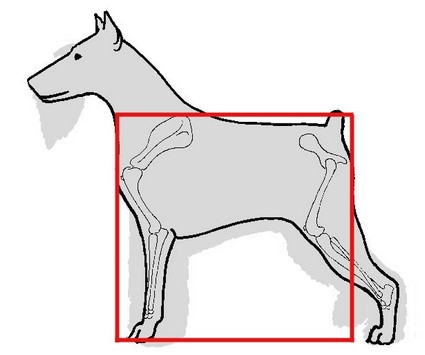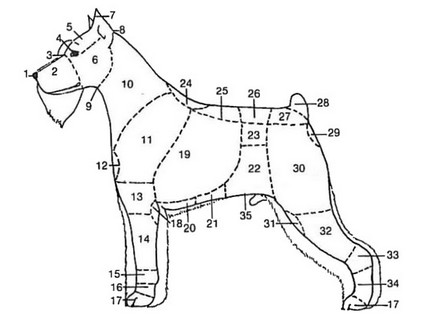AKC
- Standard

Approved January 25, 1991 - Effective February 27, 1991 (AMSC)

| Origin:
Germany |
 |
 |
 |
| Classification
AKC: Terrier Group |
 |
 |
 |
|
History:
The
Schnauzer is of German origin, said to be recognizable
in pictures of the 15th century. The Miniature Schnauzer
is derived from the Standard Schnauzer and is said to
have come from mixing of Affenpinschers and Poodles with
small Standards. The Miniature Schnauzer was exhibited
as a distinct breed as early as 1899. Miniature Schnauzers
have been bred in the United States since 1925 and have
gained steadily in popular favor. The American Miniature
Schnauzer Club began its independent operation in August
1933.
|
 |
 |
 |
|
General
Appearance: The
Miniature Schnauzer is a robust, active dog of terrier
type, resembling his larger cousin, the Standard Schnauzer,
in general appearance, and of an alert, active disposition.
Faults
- Type
- Toyishness, ranginess or coarseness.
|
|

|
|

|
|

|
|
Size,
Proportion, Substance
Size
- From 12 to 14 inches. He is sturdily built, nearly square
in proportion of body length to height with plenty of
bone, and without any suggestion of toyishness.
Disqualifications - dogs or bitches under 12 inches
or over 14 inches.
|
|

nearly square
in proportion of body length to height
|
 |
 |
 |
|

Points of the Dog as shown on the
Miniature Schnauzer
|
|
01 - Nase
02 - Muzzle; foreface
03 - Stop
04 - Eye
05 - Skull; forehead
06 - Cheek
07 - Ear
08 - Occiput
09 - Throat
10 - Neck
11 - Shoulder
12 - Point of Shoulder
|
13 - Upper arm
14 - Forearm
15 - Knee
16 - Front pastern
17 - Foot; paw
18 - Elbow
19 - Ribs
20 - Brisket
21 - Abdomen; belly
22 - Flank
23 - Coupling
24 - Withers
|
25 - Back
26 - Loin
27 - Croup; rump
28 - Tail; stern
29 - Point of buttock
30 - Thigh
31 - Stifle
32 - Gaskin; second thigh
33 - Hock
34 - Back pastern
35 - Tuck-up
|
|
LENGTH of the Schnauzer is measured
from the point of shoulder (12) to the point of buttock
(29)
HEIGHT of the Schnauzer is measured from the withers
(24) to ground
LENGTH should approximate HEIGHT of the Schnauzer
FOREQUARTERS consist of the area beginning at the
withers (24) and include 11, 12, 13, 14, 15, 16 und 17
HINDQUARTERS consist of the area beginning at the croup
(27) and include 30, 32, 33, 34 und 17
BACKLINE includes the withers, back, loin and croup
|
 |
 |
 |


Head

Eyes
- Small, dark brown and deepset. They are oval in appearance
and keen in expression.
Faults - Eyes light and/or large and prominent in appearance.
Ears - When cropped, the ears are identical in shape
and length with pointed tips. They are in balance with the head
and not exaggerated in length. They are set high on the skull
and carried perpendicularly at the inner edges, with as little
bell as possible along the outer edges. When uncropped, the
ears are small and V-shaped, folding close to the skull.
Head
- Strong and rectangular, its width diminishing slightly from
ears to eyes, and again to the tip of the nose. The forehead
is unwrinkled. The topskull is flat and fairly long. The foreface
is parallel to the topskull, with a slight stop, and it is at
least as long as the topskull. The muzzle is strong in proportion
to the skull; it ends in a moderately blunt manner, with thick
whiskers which accentuate the rectangular shape of the head.
Faults - Head coarse and cheeky.
Jaws -
The
teeth meet in a scissors bite. That is, the upper front teeth
overlap the lower front teeth in such a manner that the inner
surface of the upper incisors barely touch the outer surface
of the lower incisors when the mouth is closed.
Faults - Bite - Undershot or overshot jaw. Level bite.
Neck,
Topline, Body

Neck
- Strong and well arched, blending into the shoulders, and
with the skin fitting tightly at the throat.
Body - Short and deep, with the brisket extending at
least to the elbows. Ribs are well sprung and deep, extending
well back to a short loin. The underbody does not present
a tucked up appearance at the flank. The backline is straight;
it declines slightly from the withers to the base of the tail.
The withers form the highest point of the body. The overall
length from chest to buttock appears to equal the height at
the withers.
Faults - Chest too broad or shallow in brisket. Hollow
or roach back.
Tail - Set high and carried erect. It is docked only
long enough to be clearly visible over the backline of the
body when the dog is in proper length of coat.
Fault - Tail set too low.

Forequarters

Forelegs
are straight and parallel when viewed from all sides. They
have strong pasterns and good bone. They are separated by
a fairly deep brisket which precludes a pinched front. The
elbows are close, and the ribs spread gradually from the first
rib so as to allow space for the elbows to move close to the
body.
Fault - Loose elbows.
The sloping shoulders are muscled, yet flat and clean. They
are well laid back, so that from the side the tips of the
shoulder blades are in a nearly vertical line above the elbow.
The tips of the blades are placed closely together. They slope
forward and downward at an angulation which permits the maximum
forward extension of the forelegs without binding or effort.
Both the shoulder blades and upper arms are long, permitting
depth of chest at the brisket.
Feet - Short and round (cat feet) with thick, black
pads. The toes are arched and compact.

Hindquarters

The
hindquarters have strong-muscled, slanting thighs. They are
well bent at the stifles. There is sufficient angulation so
that, in stance, the hocks extend beyond the tail. The hindquarters
never appear overbuilt or higher than the shoulders. The rear
pasterns are short and, in stance, perpendicular to the ground
and, when viewed from the rear, are parallel to each other.
Faults - Sickle hocks, cow hocks, open hocks or bowed
hindquarters.

Coat

Double,
with hard, wiry, outer coat and close undercoat. The head,
neck, ears, chest, tail, and body coat must be plucked. When
in show condition, the body coat should be of sufficient length
to determine texture. Close covering on neck, ears, and skull.
Furnishings are fairly thick but not silky.
Faults - Coat too soft or too smooth and slick in
appearance.

Colour

The
recognized colors in the US are salt and pepper, black and silver and
solid black. All colors have uniform skin pigmentation, i.e.
no white or pink skin patches shall appear anywhere on the
dog.
Salt and Pepper - The typical salt and pepper color
of the topcoat results from the combination of black and white
banded hairs and solid black and white unbanded hairs, with
the banded hairs predominating. Acceptable are all shades
of salt and pepper, from the light to dark mixtures with tan
shadings permissible in the banded or unbanded hair of the
topcoat. In salt and pepper dogs, the salt and pepper mixture
fades out to light gray or silver white in the eyebrows, whiskers,
cheeks, under throat, inside ears, across chest, under tail,
leg furnishings, and inside hind legs. It may or may not also
fade out on the underbody. However, if so, the lighter underbody
hair is not to rise higher on the sides of the body than the
front elbows.
Black and Silver - The black and silver generally follows
the same pattern as the salt and pepper. The entire salt and
pepper section must be black. The black color in the topcoat
of the black and silver is a true rich color with black undercoat.
The stripped portion is free from any fading or brown tinge
and the underbody should be dark.
Black - Black is the only solid color allowed. Ideally,
the black color in the topcoat is a true rich glossy color
with the undercoat being less intense, a soft matting shade
of black. This is natural and should not be penalized in any
way. The stripped portion is free from any fading or brown
tinge. The scissored and clippered areas have lighter shades
of black. A small white spot on the chest is permitted, as
is an occasional single white hair elsewhere on the body.
Disqualifications
- Color solid white or white striping, patching, or spotting
on the colored areas of the dog, except for the small white
spot permitted on the chest of the black. The body coat color
in salt and pepper and black and silver dogs fades out to light
gray or silver white under the throat and across the chest.
Between them there exists a natural body coat color. Any irregular
or connecting blaze or white mark in this section is considered
a white patch on the body, which is also a disqualification.

Gait

The
trot is the gait at which movement is judged. When approaching,
the forelegs, with elbows close to the body, move straight forward,
neither too close nor too far apart. Going away, the hind legs
are straight and travel in the same planes as the forelegs. Note
- It is generally accepted that when a full trot is achieved,
the rear legs continue to move in the same planes as the forelegs,
but a very slight inward inclination will occur. It begins
at the point of the shoulder in front and at the hip joint
in the rear. Viewed from the front or rear, the legs are straight
from these points to the pads. The degree of inward inclination
is almost imperceptible in a Miniature Schnauzer that has
correct movement. It does not justify moving close, toeing
in, crossing, or moving out at the elbows.
Viewed
from the side, the forelegs have good reach, while the hind
legs have strong drive, with good pickup of hocks. The feet
turn neither inward nor outward.
Faults - Single tracking, sidegaiting, paddling in front,
or hackney action. Weak rear action.

Temperament

The
typical Miniature Schnauzer is alert and spirited, yet obedient
to command. He is friendly, intelligent and willing to please.
He should never be overaggressive or timid.


Disqualification

Dogs
or bitches under 12 inches or over 14 inches. Color solid white
or white striping, patching, or spotting on the colored areas
of the dog, except for the small white spot permitted on the
chest of the black. The body coat color in salt and pepper and
black and silver fades out to light gray or silver white under
the throat and across the chest. Between them there exists a
natural body coat color. Any irregular or connecting blaze or
white mark in this section is considered a white patch on the
body, which is also a disqualification.
AKC Schnauzer Standard and more information on WIKIPEDIA
AKC Miniature Schnauzer Standard and more information on WIKIPEDIA
AKC Giant Schnauzer Standard and more information on WIKIPEDIA

|